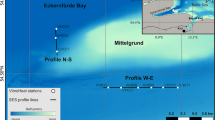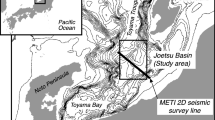Abstract
A basic premise in marine heat flow studies is that the temperature gradient varies with depth as a function of the bulk thermal conductivity of the sediments. As sediments become more deeply buried, compaction reduces the porosity and causes an increase in the bulk thermal conductivity. Therefore, while the heat flow may remain constant with depth, the thermal gradient is not necessarily linear. However, it has been argued that measurements showing increased sediment thermal conductivity with burial depth may be caused by a horizontal measurement bias generated by increasing anisotropy in sediments during consolidation. This study reanalyses a synthesis of Ocean Drilling Program data from 186 boreholes, and investigates the occurrence of nonlinear geothermal gradients in marine sediments. The aim is to identify whether observed downhole changes in thermal conductivity influence the measured temperature gradient, and to investigate potential errors in the prediction of in-situ temperatures derived from the extrapolation of near-surface thermal gradients. The results indicate that the measured thermal conductivity does influence the geothermal gradient. Furthermore, comparisons between shallow measurements (<10 m) from surface heat flow surveys and the deeply constrained temperature data from 98 ODP boreholes indicate that the shallow gradients are consistently higher by on average 19 °C km–1. This is consistent with higher porosity and generally lower thermal conductivity in near-seafloor sediments, and highlights the need to develop robust porosity–thermal conductivity models to accurately predict temperatures at depth from shallow heat flow surveys.









Similar content being viewed by others
References
Artemieva IM, Mooney WD (2001) Thermal thickness and evolution of Precambrian lithosphere: a global study. J Geophys Res 106:16387. doi:10.1029/2000JB900439
Athy LF (1930) Density, porosity, and compaction of sedimentary rocks. AAPG Bull 14:1–24
Beardsmore GR, Cull JP (2001) Crustal heat flow: a guide to measurement and modelling. Cambridge University Press, Cambridge
Bullard EC (1939) Heat flow in South Africa. Proc R Soc Lond Ser Math Phys Sci 173:474–502
Chapman DS (1986) Thermal gradients in the continental crust. Geol Soc Lond Spec Publ 24:63–70. doi:10.1144/GSL.SP.1986.024.01.07
Chapman D, Keho T, Bauer M, Picard M (1984) Heat flow in the Uinta Basin determined from bottom hole temperature (BHT) data. Geophysics 49:453–466. doi:10.1190/1.1441680
Davies JH (2013) Global map of solid Earth surface heat flow. Geochem Geophys Geosyst 14:4608–4622. doi:10.1002/ggge.20271
Gibson RE (1958) The progress of consolidation in a clay layer increasing in thickness with time. Geotechnique 8:171–182. doi:10.1680/geot.1958.8.4.171
Gosnold WD, Panda B (2002) The global heat flow database of the international heat flow commission. http://www.und.edu/org/ihfc/index2.html
Grevemeyer I, Villinger H (2001) Gas hydrate stability and the assessment of heat flow through continental margins. Geophys J Int 145:647–660. doi:10.1046/j.0956-540x.2001.01404.x
Grose CJ (2012) Properties of oceanic lithosphere: revised plate cooling model predictions. Earth Planet Sci Lett 333–334:250–264. doi:10.1016/j.epsl.2012.03.037
Hasterok D (2013) A heat flow based cooling model for tectonic plates. Earth Planet Sci Lett 361:34–43. doi:10.1016/j.epsl.2012.10.036
Hyndman RD, Erickson AJ, Von Herzen RP (1974) Geothermal measurements on DSDP Leg 26. In: Davies TA, Luyendyk BP et al., Init Repts DSDP 26:451–463
Kukkonen IT (1988) Terrestrial heat flow and groundwater circulation in the bedrock in the central Baltic Shield. Tectonophysics 156:59–74. doi:10.1016/0040-1951(88)90283-1
Mondol NH, Bjørlykke K, Jahren J, Høeg K (2007) Experimental mechanical compaction of clay mineral aggregates—changes in physical properties of mudstones during burial. Mar Pet Geol 24:289–311. doi:10.1016/j.marpetgeo.2007.03.006
Moore JC, Saffer D (2001) Updip limit of the seismogenic zone beneath the accretionary prism of southwest Japan: an effect of diagenetic to low-grade metamorphic processes and increasing effective stress. Geology 29:183–186. doi:10.1130/0091-7613(2001)029<0183:ULOTSZ>2.0.CO;2
O’Regan M, Moran K (2010) Deep water methane hydrates in the Arctic Ocean: reassessing the significance of a shallow BSR on the Lomonosov Ridge. J Geophys Res Solid Earth 115, B05102. doi:10.1029/2009JB006820
O’Regan M, Moran K, Baxter CDP, Cartwright J, Vogt C, Kölling M (2010) Towards ground truthing exploration in the central Arctic Ocean: a Cenozoic compaction history from the Lomonosov Ridge. Basin Res 22:215–235. doi:10.1111/j.1365-2117.2009.00403.x
Pollack HN, Hurter SJ, Johnson JR (1993) Heat flow from the Earth’s interior: analysis of the global data set. Rev Geophys 31:267–280. doi:10.1029/93RG01249
Powell WG, Chapman DS, Balling N, Beck AE (1988) Continental heat-flow density. In: Haenel R, Rybach L, Stegena L (eds) Handbook of terrestrial heat-flow density determination. Springer, Dordrecht, pp 167–222
Pribnow D, Kinoshita M, Stein C (2000) Thermal data collection and heat flow recalculations for Ocean Drilling Program Legs 101–180. ODP Heat Flow Rep, pp 1–25
Ratcliffe EH (1960) The thermal conductivities of ocean sediments. J Geophys Res 65:1535–1541
Stein CA, Abbott DH (1991) Implications of estimated and measured thermal conductivity for oceanic heat flow studies. Mar Geophys Res 13:311–329. doi:10.1007/BF00366281
Terzaghi K (1943) Theoretical soil mechanics. Wiley, New York
Tissot BP, Pelet R, Ungerer P (1987) Thermal history of sedimentary basins, maturation indices, and kinetics of oil and gas generation. AAPG Bull 71:1445–1466
Villar-Muñoz L, Behrmann JH, Diaz-Naveas J, Klaeschen D, Karstens J (2013) Heat flow in the southern Chile forearc controlled by large-scale tectonic processes. Geo-Mar Lett 34:185–198. doi:10.1007/s00367-013-0353-z
Wallmann K, Pinero E, Burwicz E, Haeckel M, Hensen C, Dale A, Ruepke L (2012) The global inventory of methane hydrate in marine sediments: a theoretical approach. Energies 5:2449–2498. doi:10.3390/en5072449
Acknowledgements
Funding for M. O’Regan and C. Stranne was provided by the Swedish research Council (VR). This research used data from the Ocean Drilling Program (ODP). ODP was sponsored by the U.S. National Science Foundation (NSF) and participating countries under management of Joint Oceanographic Institutions (JOI), Inc. We acknowledge constructive comments from an anonymous reviewer and the journal editors.
Author information
Authors and Affiliations
Corresponding author
Ethics declarations
Conflict of interest
The authors declare that there is no conflict of interest with third parties.
Electronic supplementary material
Below is the link to the electronic supplementary material.
ESM 1
(PDF 318 kb)
Rights and permissions
About this article
Cite this article
Stranne, C., O’Regan, M. Conductive heat flow and nonlinear geothermal gradients in marine sediments—observations from Ocean Drilling Program boreholes. Geo-Mar Lett 36, 25–33 (2016). https://doi.org/10.1007/s00367-015-0425-3
Received:
Accepted:
Published:
Issue Date:
DOI: https://doi.org/10.1007/s00367-015-0425-3




